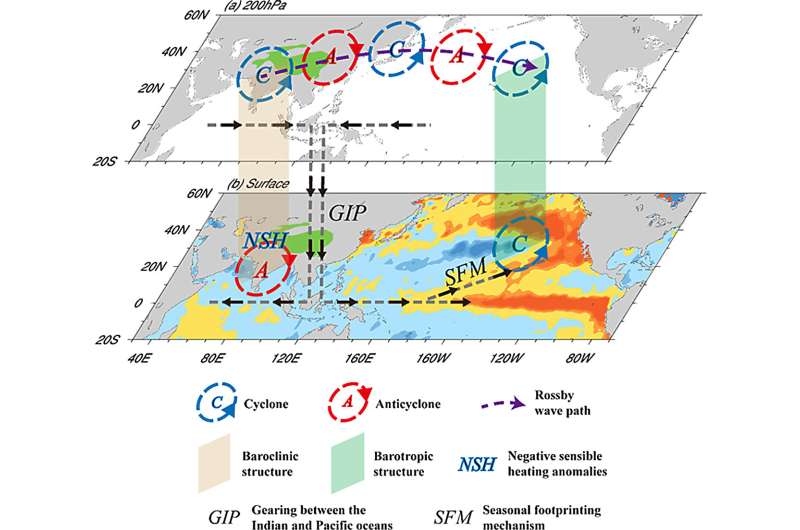This article has been reviewed according to Science X's editorial process and policies. Editors have highlighted the following attributes while ensuring the content's credibility:
fact-checked
trusted source
proofread
The Tibetan Plateau bridge: Remote climate effects of extratropical and tropical forcing

The Tibetan Plateau (TP), which is located in the subtropics of eastern Eurasia, could act as a bridge spanning from the mid-to-high-latitude forcing on the tropical climate, as well as from the tropical region to subtropical systems. Knowledge of the TP bridge and its role in climate variability has advanced over the past several years.
Recently, in a paper published in Atmospheric and Oceanic Science Letters, scientists from the State Key Laboratory of Numerical Modeling for Atmospheric Sciences and Geophysical Fluid Dynamics, Institute of Atmospheric Physics, Chinese Academy of Sciences, and the School of Atmospheric Sciences at Sun Yat-sen University, reviewed recent advances in the bridging roles of the TP in terms of the remote influence of circulation anomalies over the North Atlantic Ocean on Asian monsoon and El Niño–Southern Oscillation (ENSO) events, and in a clear link between the tropical oceans and Asian climate anomalies.
"The winter–spring North Atlantic tripole pattern of sea surface temperature anomalies significantly affects the seasonal transition of the South Asian monsoon and the triggering of ENSO events on the interannual timescale. A distinct negative sensible heating–baroclinic structure in May over the TP provides an intermediate bridging effect in this Atlantic–Asian-Pacific connection, as shown in the figure," explains the second author of the study, Dr. Yu Wei.
"The TP also plays an intermediate role in the process of the summer North Atlantic Oscillation affecting the East Asian summer monsoon."
"The suppressed TP convection plays a crucial bridging role in the influence of Maritime Continent convection on extreme drought over Southeast China," says Jiang Jilan, corresponding author of the study.
Another member of the team, Dr. Ma Tingting, also says, "The tropical ocean or the midlatitude quasi-bicycle wave train affect the intraseasonal variation in extreme precipitation in East China through the intraseasonal variation of high potential vorticity systems and surface sensible heating over the TP."
"The TP will continue to play unique roles in the warming of the global climate," emphasizes Prof. Liu Yimin, the first author of the study. "However, collaborative efforts are still needed as we strive to move forwards with observing, simulating, and ultimately better understanding the climatic roles played by the TP and the underlying dynamic mechanisms involved."
More information: Yimin Liu et al, The Tibetan Plateau bridge: Influence of remote teleconnections from extratropical and tropical forcings on climate anomalies, Atmospheric and Oceanic Science Letters (2023). DOI: 10.1016/j.aosl.2023.100396
Provided by Chinese Academy of Sciences



















